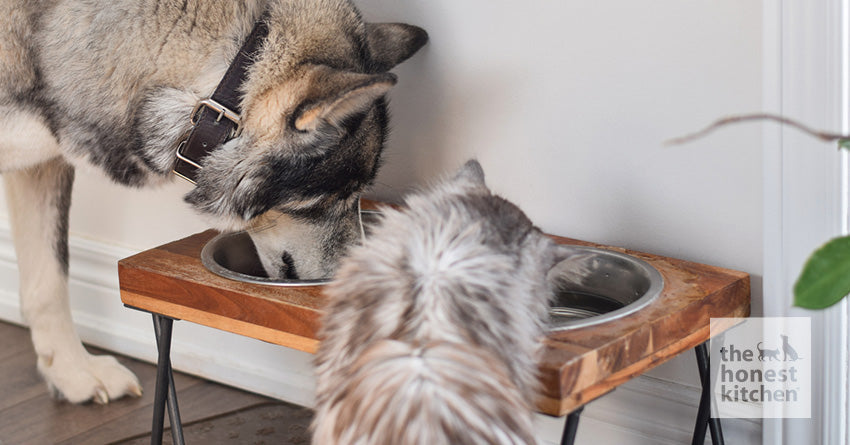Changing your dog's diet can be a significant shift in their routine. Whether it's a transition from puppyhood to adulthood, introducing a new brand for better nutrition, or adapting to a diet that suits specific medical conditions, each scenario demands careful consideration.
This shift in their eating habits, while necessary, can be challenging. It's not just about swapping one food for another; it's about ensuring a seamless and healthy changeover for your beloved pet's well-being. Let's explore how to make this transition smooth and stress-free for both you and your pet.
A Step-by-Step Guide for Transitioning Your Dog's Food
Are you embarking on the journey of changing your dog's diet? It's essential to follow a structured, day-by-day guide. This methodical approach not only eases your pet into their new food from their old diet but also allows you to monitor their reaction to the change.
Typically, a complete transition takes about five to seven days, though it can vary based on individual needs. Some dogs may adapt within a quick three-day period, while others might require up to two weeks, especially if they have sensitive stomachs or specific dietary needs.
Here's a tried-and-true schedule to guide you through the process:
Day 1: Start with a ratio of ⅛ of the new food mixed with ⅞ of the old food.
Day 3: Increase the new food to ¼, blending it with ¾ of the old food.
Day 5: Now, make it half and half — ½ new food and ½ old food.
Day 7: Shift the ratio to ¾ new food and ¼ old food.
Day 9: Complete the switch with 100% new food.
Remember, this is a general guide. Pay close attention to your dog's reaction at each stage and adjust as needed for their comfort and overall health.
Why Is Transitioning Dog Food Challenging for Some Dogs?
When it comes to switching dog foods, the challenge often lies in their nature. Dogs heavily rely on their sense of smell to identify what they eat. Introducing a new scent into their diet can initially lead to hesitation or reluctance. It's not just about taste; it's also their instinctive response to something unfamiliar in their bowl.
Another significant factor is gut health. Dog digestive systems become attuned to a specific type of food over time, developing a unique gut bacteria balance. Introducing a new diet abruptly may sometimes disrupt this balance, leading to digestive discomfort or sensitivity.
This is why a gradual transition is crucial — it gives their system time to adjust to new ingredients and compositions.
Sticking with the same manufacturer can sometimes ease this process. Often, brands maintain a consistent ingredient base across different products, which means fewer completely new elements for your dog's system to adapt to.
However, even minor alterations can impact how your dog reacts to the new food, especially if they’re a picky eater.
At The Honest Kitchen, we understand that it’s not always easy for dogs to transition to a new food. With high-quality proteins and thoughtfully sourced whole food ingredients, we take pride in our nutritious, delicious recipes that even the pickiest eaters can enjoy — making the transition to an Honest Kitchen recipe that much smoother!
Reasons for Transitioning Your Dog's Food
Puppy to Adulthood
The shift from puppyhood to adulthood is a significant phase in your dog's life. During this time, dietary needs change as they move out of their rapid growth phase.
If you're feeding your dog a specific puppy food, transitioning to an adult formula within the same brand can usually be done over a three-day period.
However, if you're considering switching to a different brand for the adult dog food, a longer transition period of around five to seven days may make for a more comfortable adjustment.
It's important to note that if the recipe changes significantly (even within the same brand), your dog may initially show some aversion or digestive sensitivity.
Medical Conditions That Require a Diet Change
Sometimes, changes in your dog's health may require a dietary shift. Various health conditions can alter a dog's nutritional needs, making it necessary to switch to a specialized diet.
This transition must be handled with care, as their system is already adapting to health changes. The new diet should cater to their specific health requirements without causing additional stress on their digestive system. A gradual transition, closely monitored by your veterinarian for any adverse reactions, is crucial in such scenarios.
Adult to Senior
As dogs age, their metabolism slows down while their nutritional needs evolve. Senior dogs often require diets that are easier to digest and lower in calories to maintain a healthy weight.
Transitioning to a senior-specific formula should be a gradual process, allowing their body to adjust to the new nutritional composition that supports their changing health needs. This transition is not just about age, but also about maintaining your dog’s quality of life during their golden years.
What Should I Do If My Dog Doesn’t Like Their New Food?
Slow Down the Transition
The key to any big change is to take it slow. If your dog is developing soft stools or showing signs of gassiness, these could be indicators that their system is struggling with the change.
In such cases, it's advisable to extend the transition period. Stretching it out to two weeks or even longer allows their digestive system to gradually adjust to the new food.
Focus on Tolerance, Not Just Enjoyment
While we all want our dogs to enjoy their meals, the priority during a food transition is to make sure that they tolerate the new food well. Digestive tolerance is a critical aspect of their overall health and comfort.
By slowing down the transition, you give your dog's gut flora time to adapt, which can also help them become more accepting of the new food over time.
Understand Their Reaction
It's important to recognize that a dog's reluctance to eat new food might not stem from the taste but from how the food makes them feel. A new diet may initially cause digestive discomfort, leading to a natural aversion. Monitoring your dog’s reaction closely and adjusting the transition pace can make a significant difference in how they accept their new diet.
Remember, every dog is unique; what works for one might not work for another. Patience and careful observation are key in ensuring a successful and healthy dietary transition for your furry friend.
Is It Bad To Switch a Dog's Food Without Transitioning Gradually?
When considering a change to your dog's diet, the question of whether to transition gradually is crucial for their health and comfort. Here's what you need to know:
Adaptation to regular changes: Dogs that are used to regular changes in their diet may adapt more quickly to new foods. In such cases, the transition time can be shorter, as their digestive systems are somewhat trained to handle variations.
Benefits of diversity: Introducing different types of foods can be beneficial for the microflora in your dog's gut. A varied diet can improve the diversity of gut bacteria, which is important for overall gut health. However, these changes should still be done gradually to avoid digestive upset.
Switching within the same brand: Generally, transitioning between products of the same brand is easier than constantly switching between different companies.
The importance of a transition period: Regardless of the situation, there should always be a transition period when changing dog food. Sudden changes can lead to acute intolerances, such as vomiting, diarrhea, or other digestive issues. These symptoms aren’t just uncomfortable but can also lead to longer-term health issues if not managed properly.
Is It Bad To Keep Your Dog On the Same Food for Life?
Consistency vs. Change
It's absolutely fine to keep your dog on the same food throughout their life, especially if it's working well for them. However, introducing the concept of rotational feeding may be beneficial.
This involves periodically changing their diet to include different proteins and ingredients, providing a variety of nutrients and flavors. This approach can enhance their overall nutrition and prevent mealtime boredom.
Monitoring for Signs of Intolerance:
It’s important to be vigilant for potential signs that your dog’s current food might not be the best fit anymore. Look out for:
Shedding and itching: Excessive shedding or itching can sometimes be linked to dietary intolerances or allergies.
Stool quality: Pay attention to the consistency and regularity of your dog's stool. Changes can indicate dietary issues.
Flatulence: If your dog starts having excessive gas, especially during a food transition, it might suggest that the new food isn't agreeing with them.
Stool odor: An extra stinky stool can indicate the development of unhealthy bacteria in the gut.
Vomiting/regurgitation: These are clear signs of intolerance and should prompt a reassessment of your dog’s diet.
While these signs may be symptoms of food intolerance, there’s a chance they could signal underlying health issues. If you notice any of these issues with your pup, be sure to check in with your vet to rule out anything more serious.
Transitioning Foods
If you do decide to transition your dog to a new food, it's crucial to do so gradually. This approach helps you monitor their reaction to the new diet and adjust accordingly.
Transitioning isn’t just about finding a food that your dog likes; it's about picking one that agrees with their body and enhances their overall health.
While sticking to the same food is not inherently bad, being open to change, especially when it leads to improved health or better suits your dog’s changing needs, is a good practice. Observing your dog's reaction to their diet and being willing to adjust as needed is key to ensuring their long-term health and happiness.
Thinking About Switching Dog Food? Try The Honest Kitchen Today!
Transitioning your dog's food is a critical process that should be approached with care. Whether it's adjusting to a new life stage, addressing health concerns, or simply seeking a healthier diet, a gradual switch is essential.
Remember to look for signs of food intolerance and choose a diet that complements your dog’s unique needs. For those considering a change, The Honest Kitchen offers a variety of human grade foods and treats that dogs love. Not convinced? Check out our True Stories from real customers!
With our focus on quality, thoughtful ingredients and great taste, we make it easier and healthier for your furry friend to enjoy their meals and thrive.
Start your journey with The Honest Kitchen today — shop our dog food recipes here!




